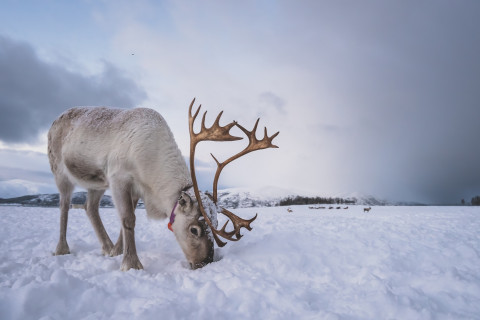In approximately half of the herding districts in Finland, basal ice events occurred more frequently in the period 1983–2016 than in the period 1948–1982. Researchers collected practitioners’ knowledge of herders from the period 1948–2016. During this period, seven winters with extensive basal ice formation were identified. Five out of seven of the most extensive basal ice formation events occurred between 1991 and 2016. Approximately one fourth of all reported mold formation events co-occurred with basal ice formation.
Basal ice formation in the terrestrial snow cover is a common phenomenon in northern circumpolar areas, one having significant impacts on ecosystems, vegetation, animals and human activities. Basal ice forming early in the winter and lasting for prolonged time is a significant risk for reindeer grazing increasing winter mortality and the need for the supplementary winter feeding, and decreasing the calving success during the subsequent spring. Another risk factor associated with warm and rainy early winters is the growth of mycotoxin-producing molds below the snow.
Processes contributing to basal ice formation, such as thaw or rain and the subsequent freezing of the snow cover, may occur more often in the future because of warmer winters and more frequent extreme warm events. There is limited knowledge on the spatial and temporal occurrence of basal ice formation because of the sparse observation network and challenges involved in detecting formation events. Also knowledge on the prevalence and frequency of mold formation, its relation to weather conditions and potential co-occurrence with basal ice events is poor. Researchers have now presented a unique dataset on the annual extent of ice formation events in northern Finland between 1948 and 2016 based on reindeer herders’ descriptions of the cold season in their management reports.
Extreme years are difficult to distinguish using only seasonal means of meteorological observations or large-scale atmospheric teleconnections such as the North Atlantic Oscillation.
Thorough analysis of local and short-lived weather events or simulation of snow cover stratigraphy will be required before detailed explanation of these ice formation events will be possible.
Results have been reported in an international journal Environmental Research Letters. Research was carried out by Sirpa Rasmus from the Arctic Centre at the University of Lapland (Finland), Sonja Kivinen from the University of Eastern Finland and Masoud Irannezhad form Southern University of Science and Technology (China). The work was funded through NCoE ReiGN by NordForsk.
For further information, please contact:
Sirpa Rasmus
Arctic Centre, University of Lapland, 040 528 2585, sirpa.rasmus(at)ulapland.fi
Sonja Kivinen, University of Eastern Finland, 040 588 4185, sonja.kivinen(at) uef.fi
Rasmus, S., Kivinen, S., Irannezhad, M. 2018. Basal ice formation in snow cover in Northern Finland between 1948 and 2016. Environ. Res. Lett. 13. 114009. http://iopscience.iop.org/article/10.1088/1748-9326/aae541/pdf
